Bitcoin Magazine
Bitcoin and the Next Wave of Institutional Capital
There are multiple approaches to valuing bitcoin and they can differ from traditional, institutional asset class valuations. The reason is that bitcoin can be regarded as a currency, a commodity, or a monetary payment network — at the same time. Bitcoin has many different characteristics which is why many different valuation approaches can be applied.
From a pure investment point of view, bitcoin has been one of the best-performing “store-of-value” investments of the past 10+ years, outperforming traditional assets like U.S. equities or gold by a very wide margin.
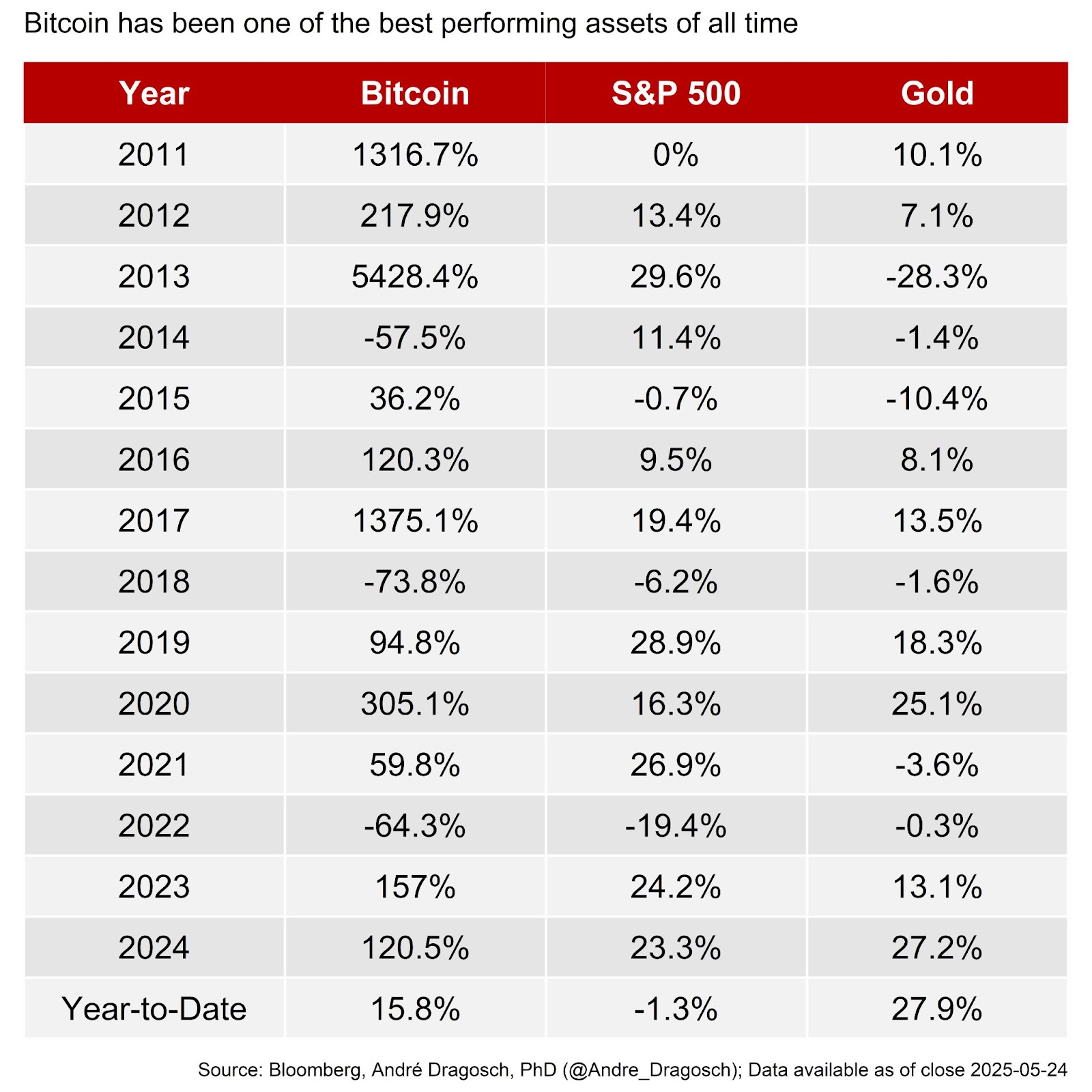
Why Adoption — Including Institutional Adoption — Will Increase Over Time
With respect to the adoption of bitcoin as a superior monetary technology, there are different segments of society that will be shaped in different ways. Think about the following:
- Individuals
Pervasive consumer price inflation has led to an erosion of purchasing power over the past decades, especially since the introduction of the fiat standard in 1971. Consumers have seen their purchasing power erode, particularly in housing.
As this erosion continues, individuals who adopt bitcoin as their primary store of value will see their purchasing power increase over time, especially relative to their social circle.
This will encourage others to copy this behavior to “keep up with the Joneses” (a Schelling Point in behavioral economics).
It is a focal point that individuals use to guide their decisions when trying to predict what others will do. Bitcoin will serve as that Schelling Point.
- Asset managers
It is widely known that only a small portfolio allocation to bitcoin can already have very significant effects on overall portfolio performance without a significant increase in portfolio volatility. In other words, a small bitcoin allocation can increase risk-adjusted returns of your portfolio, letting asset managers build more efficient portfolios.
In 2024, bitcoin was by far the best-performing major asset with a return of 121%, outperforming the S&P 500 but also the top hedge funds in the world.
In fact, bitcoin has been the best-performing major asset since 2011 in all years except 2014, 2018, and 2022.
The asset managers who added bitcoin to their multi-asset portfolio were able to outperform their peers both on an absolute and risk-adjusted basis. They will most likely win tomorrow’s Morningstar or Lipper Fund awards for outperforming their peers and exhibiting superior performance metrics.
Social and economic pressure exerted by clients and superiors will ultimately increase for those asset managers who don’t add bitcoin to their multi-asset portfolios.
In order to keep up with those who do, the only viable long-term solution will be to add bitcoin to their multi-asset portfolio, leading to increasing institutional adoption over time.
- Corporations
The economic motive to add bitcoin to corporate balance sheets is similar to that of individuals: to guard the corporate cash balances against erosions of purchasing power over time, which is suboptimal for its shareholders.
Moreover, corporations will be incentivized economically to add bitcoin to their balance sheet, because those who have outperformed their peers by a very wide margin.
Take Metaplanet in Japan, for example.
Metaplanet and its CEO Simon Gerovich were relatively unknown in Japan at the start of 2024. With a market capitalization of just JPY 1.95 billion (USD 14.5 million) at the start of 2024, Metaplanet was in the bottom 500 Japanese companies on the Topix, which tracks around 2,000 companies listed on the Tokyo Stock Exchange.
Metaplanet, normally engaged in diversified businesses such as finance, trading and real estate, publicly announced in early April 2024 that it would adopt a bitcoin standard and acquire BTC as the core asset of its treasury, committing an initial investment of 1 billion JPY (approximately 6.5 million USD).
This strategic move was inspired by MicroStrategy’s approach to bitcoin adoption. The company completed its first bitcoin purchase on April 22, 2024, acquiring 97.85 BTC for 1 billion JPY.
By the end of October 2024, Metaplanet had become the largest corporate bitcoin holder in Asia, surpassing competitors such as Nexon and Meitu.
As a result, its share price outperformed every single stock in the Topix and MSCI World in 2024, boasting a whopping +2,629% return.
Metaplanet is now among the top-5 largest corporate bitcoin holders in the world, with over 16,000 BTC on its balance sheet, according to the latest data from bitcointreasuries.net.
Metaplanet’s move is emblematic of the growing global appetite for bitcoin as part of corporate treasury strategy.
What is more is that it has very significant implications for other companies:
It is only a matter of time before not adopting bitcoin could result in a significant disadvantage for shareholders, as companies that do adopt bitcoin continue to outperform non-adopters by a wide margin.
As with asset managers, there will be increasing social and economic pressure on corporate boards and CEOs to adopt a bitcoin standard.
- Sovereigns
Sovereign adoption might have slightly different mechanics than private-sector adoption of bitcoin but the incentives are, mostly, of an economic nature as well.
El Salvador declared bitcoin legal tender in September 2021 and officially adopted a bitcoin standard. It was the very first country in the world to announce such a move. Since then, the country’s treasury has been acquiring more than 6,000 BTC.
As a result, El Salvador’s credit rating has significantly improved from a composite issuer rating of CCC+ in July 2021 to B- according to data provided by Bloomberg.
The improvement in credit rating was also due to a significant improvement in tourist arrivals and overall acceleration in GDP growth, which were also direct consequences of the move to adopt a bitcoin standard: It both fuelled domestic “animal spirits” and attracted more international visitors.
Nonetheless, this example goes a long way in demonstrating the economic benefits, direct and indirect, of adopting a bitcoin standard for nation-states.
In fact, El Salvador’s 1-year sovereign default probability declined significantly from a high of around 20% in April 2021 to slightly below 5% in March 2025, according to data provided by Bloomberg.
The decline in sovereign default probabilities is also generally beneficial for the country’s exchange rate since there is an inverse relationship between sovereign credit default swaps and exchange rates, especially in emerging market countries.
To sum up, other sovereign nations will likely be incentivized to adopt bitcoin because of the following reasons:
- Bolstering international FX reserves
- Improvement in fiscal debt situation
- Decline in sovereign debt default probabilities
- Improvement in credit ratings
- Decline in sovereign yields = improvement in financial conditions
- FX Stabilization = decline in import price inflation
- Indirect: increase in “animal spirits” and domestic GDP growth
- Long term: improvement in Net International Investment Position (IIP)
Social dynamics of Bitcoin adoption
There are several behavioral phenomena that could accelerate the adoption of bitcoin: network effects, the Lindy effect, and the Dunning-Kruger effect.
Network Effects
Network effects describe the phenomenon in economics where the usefulness or value that a user gains from a product or service increases with the number of other users utilising similar goods or services. This effect, also referred to as network externality or demand-side economies of scale, usually results in a product becoming more valuable as more people join its network.
There are two kinds of network effects: direct and indirect. Direct network effects occur when the adoption of a product by a large number of users makes the product more valuable to each user. This is different from benefits derived from price reductions due to increased adoption. Examples of platforms exhibiting direct network effects include social media sites like Twitter and Facebook, as well as services like Airbnb, Uber and LinkedIn, along with telecommunication tools such as telephones and instant messaging services.
Indirect (or cross-group) network effects arise when there are at least two distinct groups of customers that are interdependent, and the utility for at least one group increases as the other group(s) grow. An example of this is the increased value of hardware to consumers with the availability of more compatible software.
Thus, the spread of technology can be significantly influenced by network effects, making adoption self-reinforcing.
- In the context of bitcoin, the network effect implies that, as the Bitcoin network grows larger, adoption could accelerate as the size of the network could reinforce further adoption due to the higher utility that comes from using the network.
- Bitcoin’s network effects were firstly discussed in more theoretical manner by Trace Mayer in June 2015 as he outlined seven types of network effects that occur in the bitcoin ecosystem: 1) speculation, 2) merchant adoption, 3) consumer adoption, 4) security, 5) developer mindshare, 6) financialization and 7) adoption as a world reserve currency.
The Lindy Effect
The Lindy effect suggests that the future life expectancy of nonperishable entities, like ideas or technologies, is directly proportional to their current age. This means that the longer something has been around, the longer it is likely to continue existing. Longevity suggests a lower likelihood of becoming obsolete or being replaced. Originating from observations made at Lindy’s Delicatessen in New York by comedians, the concept has been further explored by mathematicians and statisticians.
This effect does not apply to perishable entities, like humans, whose life expectancy does not increase with age. The Lindy effect is relevant to items without an inherent expiration date, indicating that the probability of a technology being adopted increases with its age.
- In the context of Bitcoin, the Lindy effect implies that the likelihood that bitcoin will prevail increases with every day the network has been running successfully.
The Dunning-Kruger Effect
The Dunning-Kruger effect refers to the phenomenon where individuals with limited knowledge or skill in a particular area overestimate their competence. This cognitive bias demonstrates a systematic pattern of incorrect thinking or judgment. Biases are pervasive across various scenarios, and tendencies highlight specific patterns of thought or behavior observed among groups of individuals, although not necessarily manifested in every action.
In the context of technology adoption, the Dunning-Kruger effect can initially slow down the adoption process as people might underestimate the capabilities of new technologies and deem them irrelevant. However, as individuals invest time in understanding the technology, this effect can eventually lead to an accelerated adoption rate.
- In the context of Bitcoin, the Dunning-Kruger effect implies that, at the beginning of the adoption cycle, a high amount of (low-quality) critique and general aversion will be more likely than at the end of the adoption cycle. A high amount of unfounded critique should be viewed as an indication of an early stage of the cycle.
Quantitative model of Bitcoin adoption
“People are impinging on other people and adapting to other people. What people do affects what other people do.” – Thomas Schelling
Some researchers have noticed that bitcoin’s price performance has been following a power law very closely in the past.
Power laws are particularly useful in explaining phenomena in which minor occurrences occur frequently but major ones are uncommon. Here are some common examples where power laws can be observed:
Cities
A power law can be used to characterize the distribution of city sizes when analyzing the link between populations and cities. For example, the number of small towns and villages is far higher than that of large cities (let alone megacities like Tokyo and New York). Nonetheless, a disproportionately large share of the population lives in these big cities. Here, the power law suggests that, according to a particular mathematical relationship, the frequency of cities declines as their size grows.
Large Corporations
A power law can also be used to describe how different business sizes are distributed inside organizations. There are far more small and medium-sized businesses (SMEs) than there are major, global organizations with revenues greater than the GDPs of some nations. A power law distribution is compatible with the size distribution of these firms, which tends to be composed of many smaller companies and fewer large ones based on factors like market capitalization, number of employees or revenue.
Viruses
Power rules can be used to explain how viruses mutate or how epidemics spread. The theory is that while the majority of changes may not have much of an effect, a small number might drastically change the behavior of the virus — making it more virulent or transmissible, for example. A power law can also be used to describe the distribution of outbreak sizes, with most outbreaks being tiny, localized episodes, but a small number having the potential to expand into broad pandemics that impact millions of people.
There has indeed been some research that implies that the adoption of bitcoin as a monetary technology was spreading “like a virus.”
In general, the propagation of a virus tends to follow a power law dependent on time passed since the first infection.
In fact, a closer look at the price evolution of bitcoin reveals that the log of price has been increasing linearly with the log of time as expressed in terms of days since the Genesis block (January 3, 2009).
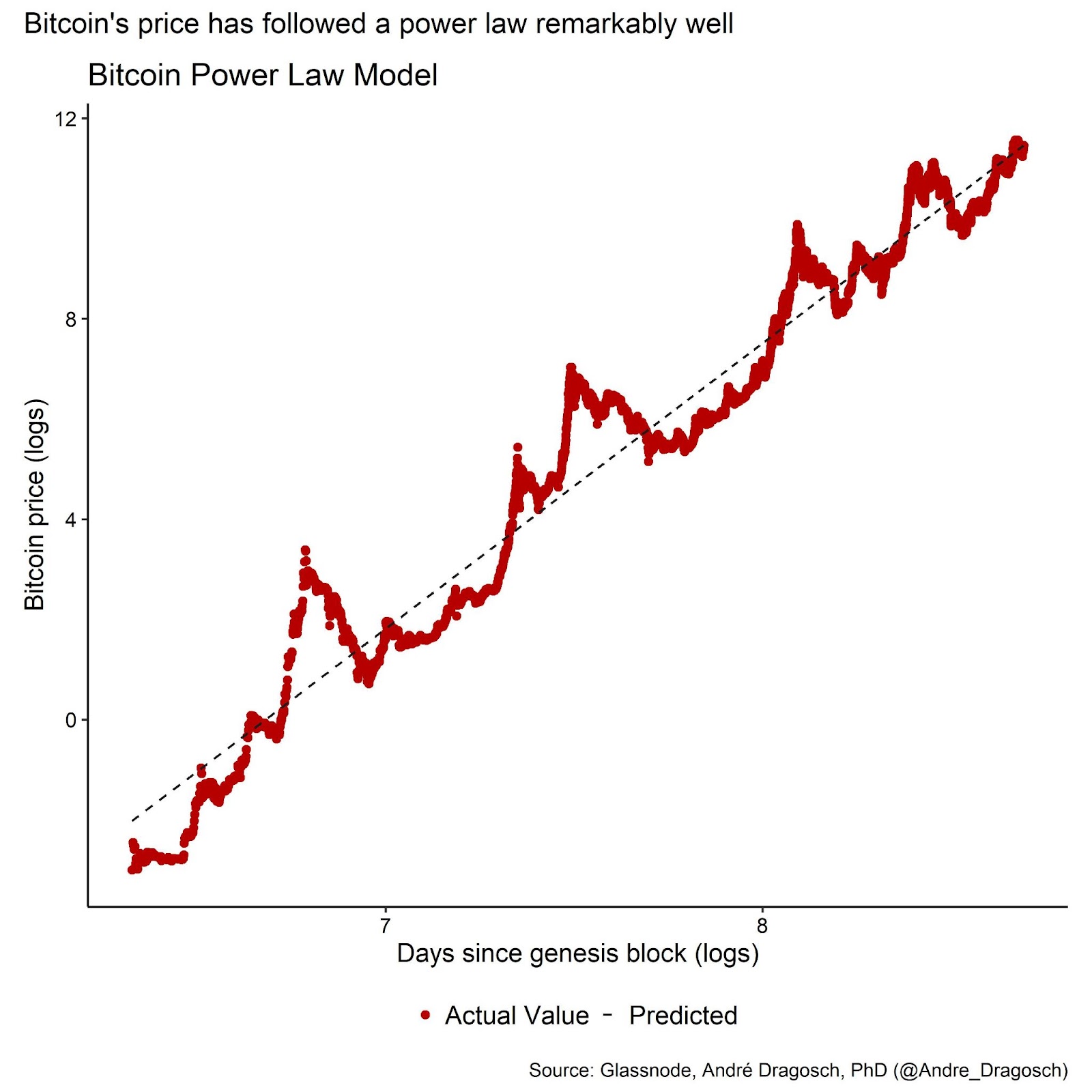
What is more is that both the number of active addresses/users as well as the hashrate of the Bitcoin network also adhere to this power law as shown in the following charts:
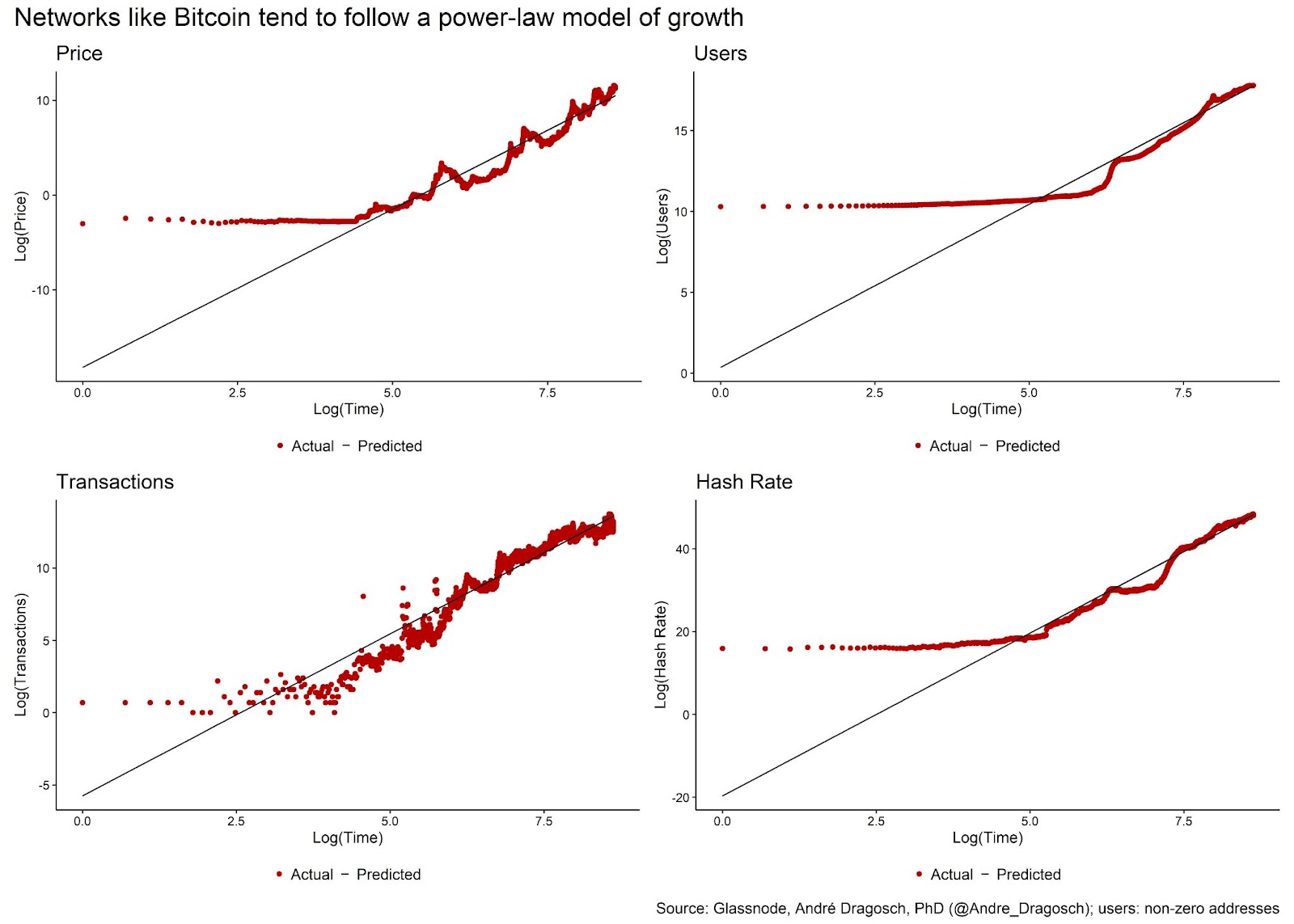
If we assume that bitcoin adoption would continue to follow such a power law in the future, the next chart suggests that the price could reach $1 million per bitcoin over the next 10 years.
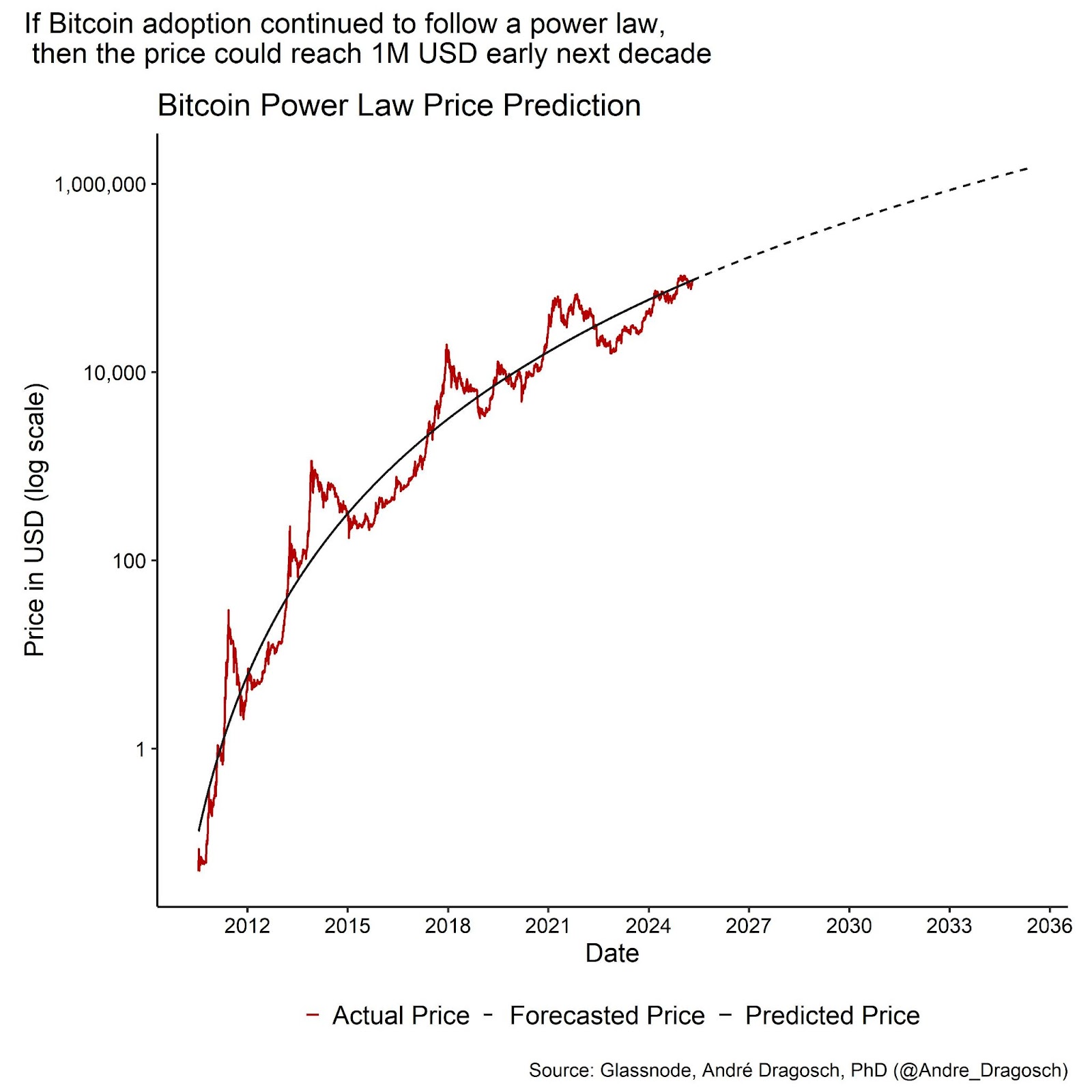
The implication of bitcoin following a power law is also that returns will decline marginally over time with increased adoption; ultimately, the adoption is “saturated.”
On a positive note, this also implies that risk/volatility will tend to decline over the long term.
Increasing Institutional Adoption and the Fractal Market Hypothesis: A Case for Lower Volatility
With increasing adoption, it is quite likely that bitcoin’s risk and volatility will also decline structurally over time.
The reason is that as market participants become more heterogeneous over time, increasing dissent among buyers and sellers is bound to have a stabilizing effect on market prices and volatility.
Imagine a high-frequency trader who might sell a position on account of a short-term trading signal. In contrast, a longer-term buy-and-hold pension fund might see a short-term decline in price as a longer-term buying opportunity; heterogeneity among investors has stabilized the price.
In contrast, market instability usually occurs in environments with increasing consensus and homogeneity among investors, e.g., many investors selling at the same time on account of the same kind of information can create price gaps/spikes.
This is also the logic of the so-called Fractal Market Hypothesis (FMH) put forth by Edgar Peters, often considered an antithesis to the dominant Efficient Market Hypothesis. The FMH assumes investors to be heterogeneous, to have imperfect information and also different investment horizons.
With respect to bitcoin, increasing heterogeneity through wider adoption also implies structurally lower volatility over time.
The following chart shows bitcoin’s price performance (upper panel) and its realized volatility (lower panel) over time. The horizontal lines represent the dates of the Bitcoin Halvings.

As one can see, bitcoin’s volatility has been decreasing structurally with every Halving.
Moreover, not only has volatility decreased but also the occurrence of extreme returns, both negative and positive, has declined significantly with every Halving. In statistician’s parlance: The return distribution has become less leptokurtic. This is shown in the following chart (each panel represents a single bitcoin epoch):
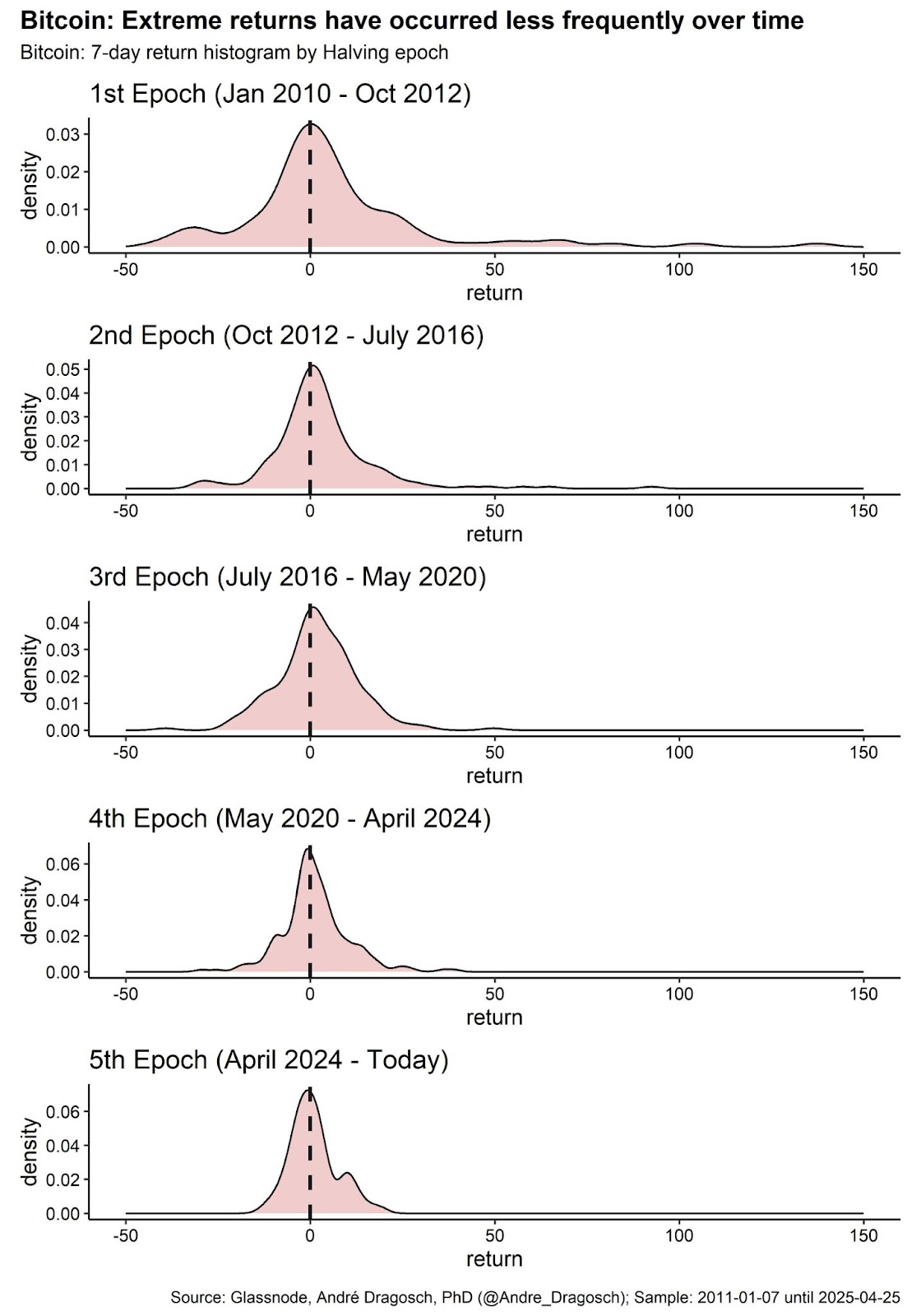
Bitcoin Halvings, which were usually followed by significant price appreciation in the past, can also be a significant driver of adoption itself as adoption usually lags increases in price.
The positive investment implication is that the risk characteristics of bitcoin will continue to change over time.
As adoption rises, bitcoin will likely evolve from a risky asset with high volatility to a safe-haven asset with low volatility.
The effect of those Halvings on bitcoin’s price performance will be analyzed in the following chapter.
Who Owns All the Bitcoin?
As far as a detailed breakdown of the holders is concerned, although the Bitcoin blockchain is highly transparent, the semi-anonymous nature does not allow for a direct identification of holders.
Furthermore, the analysis of holders is complicated by the fact that
- a single entity can control multiple wallet addresses (e.g., large single holders)
- multiple entities can be behind a single wallet address (e.g., exchange wallets)
Nonetheless, some companies have specialized in so-called “address tagging” and have created a separate database of identified bitcoin wallet addresses.
Besides, professional on-chain data providers like Glassnode provide aggregations of data, e.g., for the number of bitcoins held/controlled by exchanges, miners or ETPs.
There are also other databases such as the one maintained on bitcointreasuries.net which have compiled bitcoin holdings of corporations, governments, ETPs and other entities based on community entries and publicly available information. Although these data are generally incomplete and should be taken with a grain of salt, they provide the best overview of approximate bitcoin holdings of the different groups.
According to the latest data, most of the bitcoin supply still remains unidentified. The assumption is that these unidentified holdings are mostly controlled by individuals (52.4%).
The second-largest group of holders are exchanges like Coinbase or Binance who control around 15.1% of the supply of bitcoin. But behind these holdings are millions of individuals (and businesses) who are the ultimate owners of those bitcoin. A growing group of holders in recent years have been funds and ETPs as well as public companies (6.8% and 4.0%, respectively).
The so-called “Patoshi” holdings refer to the bitcoin holdings in wallets controlled by the creator of Bitcoin — Satoshi Nakamoto. Nakamoto’s bitcoin originally came from early mining efforts, which is why these holdings are often aggregated with overall miner holdings. They still represent a large part of the existing bitcoin supply (5.5%) but experts generally assume these holdings to be lost since they have never been moved. Probably lost coins (1.8%) are also those bitcoin holdings that have generally been idle for more than 10 years.
Although governments are still among the smallest group of bitcoin holders (2.7%), it is widely expected that government entities, including central banks and sovereign wealth funds, will increase their relative share of bitcoin’s supply over the coming years, led by efforts by the U.S. government and others to establish strategic bitcoin reserves.
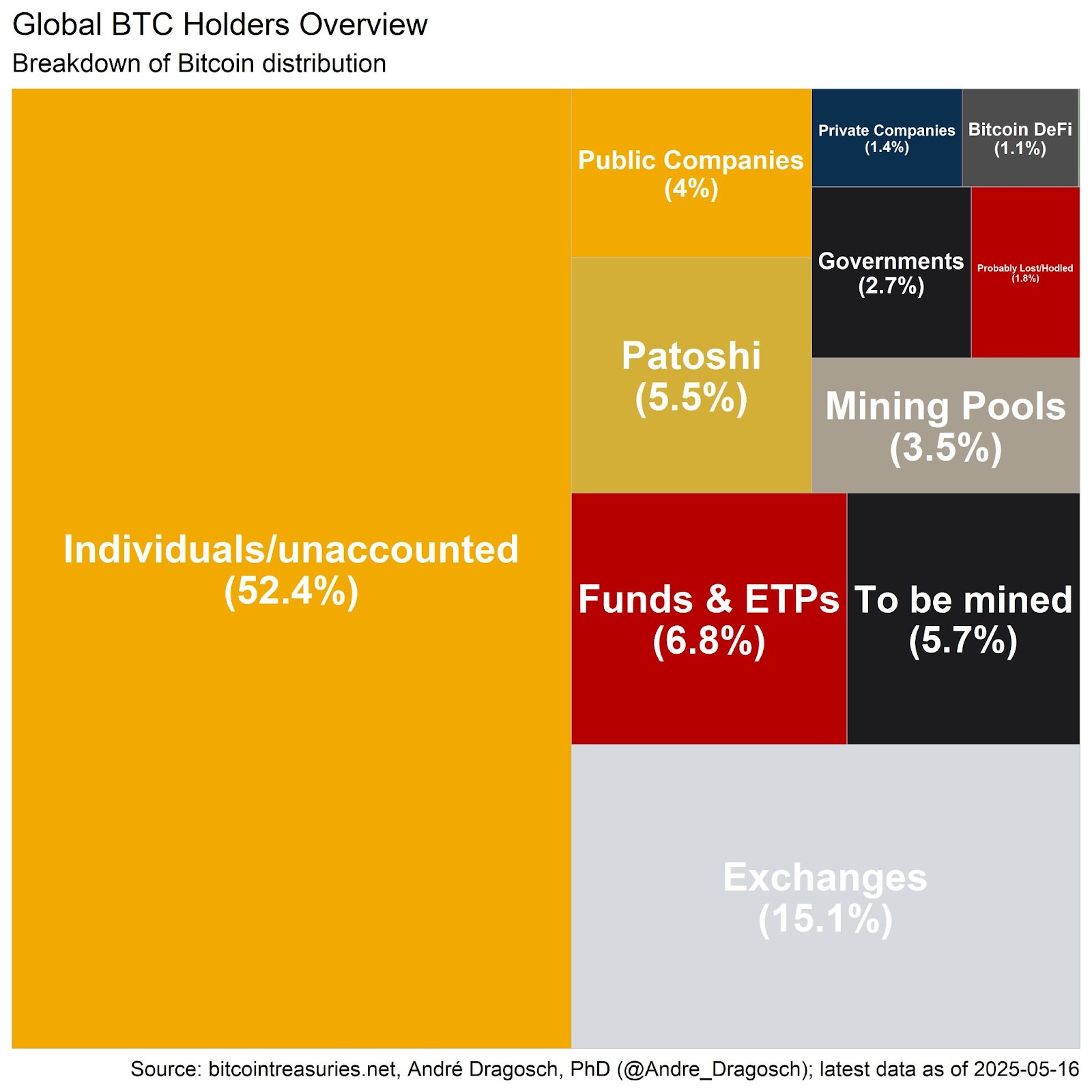
Modelling Bitcoin’s increasing scarcity over time
“The reason that Bitcoin is magical is because there’s only 21 million. […] Bitcoin is a scarcity. […] A scarcity is something of which it is absolutely capped” – Michael Saylor
The Bitcoin Halving stands out as the most eagerly awaited occurrence in cryptocurrency markets.
This event halves the block subsidy, meaning the reward that miners get for securing the blockchain by finding a valid nonce. Consequently, this leads to a 50% reduction in the rate of new bitcoin creation.
The Halving is a crucial aspect of Bitcoin’s design, promoting a gradual decrease in the rate of new supply and guaranteeing that the total number of bitcoin will not exceed 21 million. The Halving is hard-coded into the Bitcoin algorithm to occur every 210,000 blocks (around every four years).
As of this writing, the next Halving is anticipated to happen around March 2028. This upcoming event will see the block reward diminish further to 1.5625 BTC, leading to a daily output drop from approximately 450 BTC to about 225 BTC.
The Halving event is essentially a supply shock to the system.
Should demand for bitcoin stay steady, the decrease in bitcoin supply is expected to push up its equilibrium price — the price must rise to balance the reduced supply.
Historical precedents show that bitcoin’s price surged significantly in the months following past Halvings. On average, bitcoin’s value increased approximately 17 times, or 1,800%, 500 days after the Halving, based on the Halvings in 2012, 2016 and 2020.
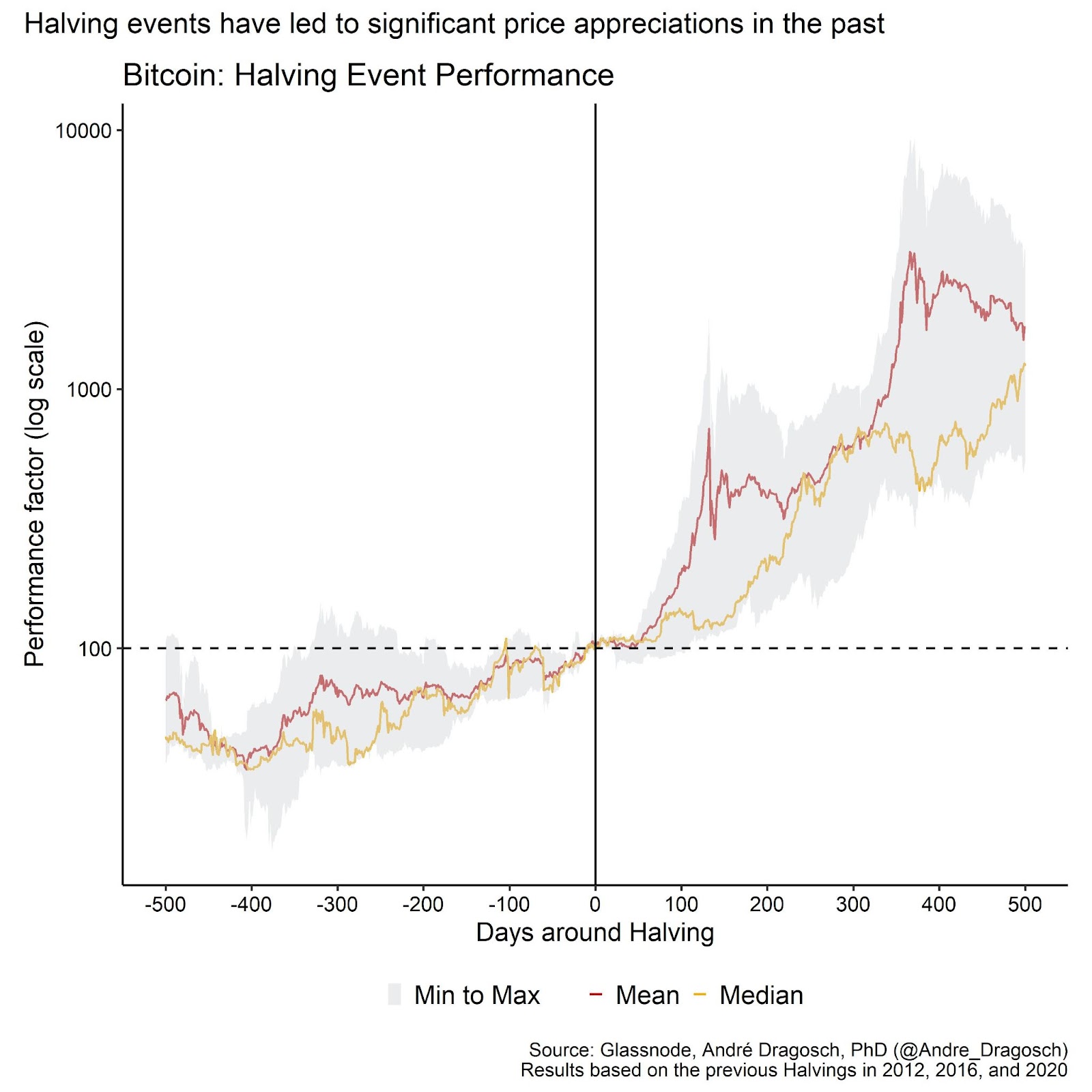
Although standard theories of capital market pricing and information theory suggest that this event should already be priced in, empirical findings indicate that the very significant price performance that followed the Halvings is unlikely to be random phenomena.
The reason is that post-Halving performances are significantly higher than pre-Halving performances.
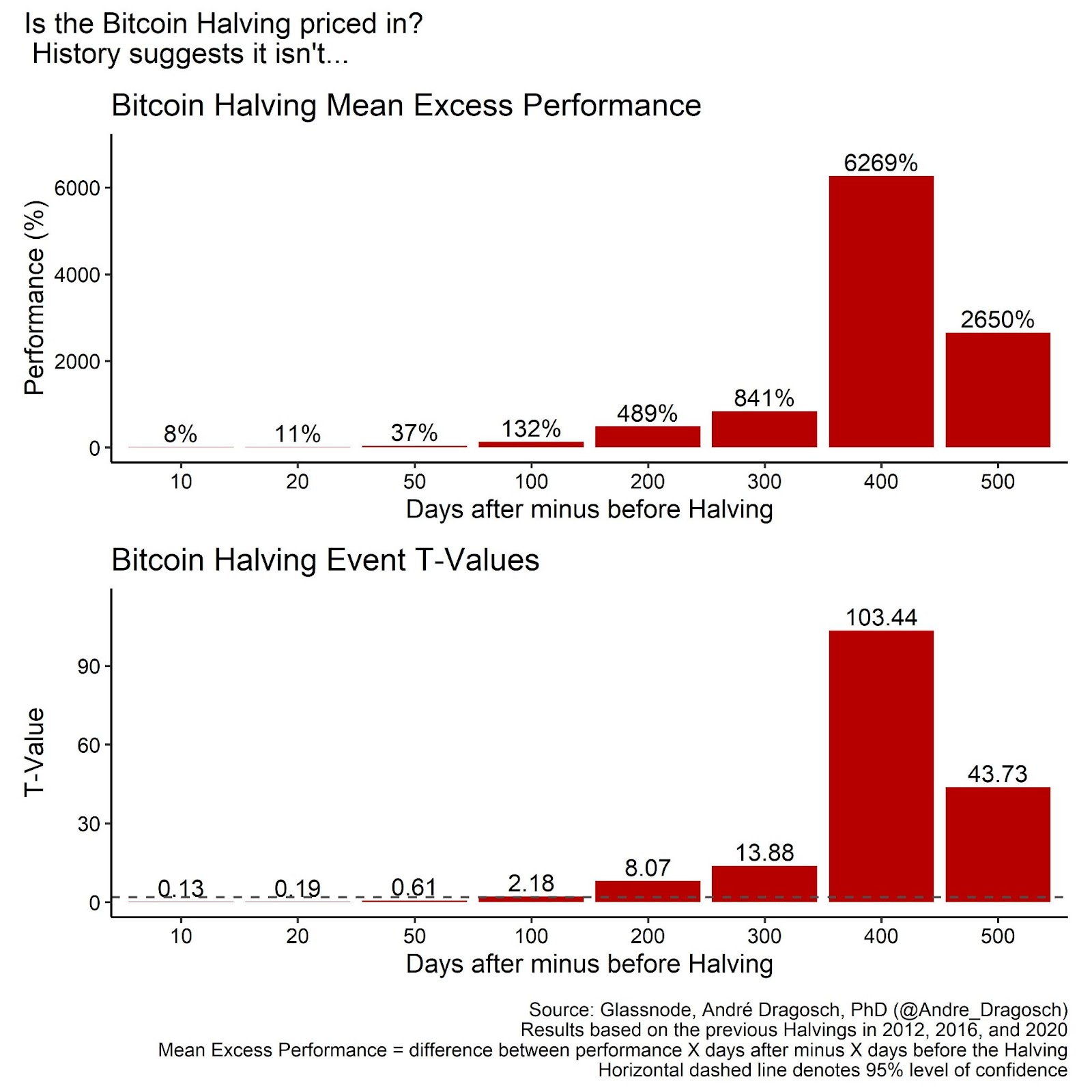
Overall, it is quite likely that prices will trend toward a higher equilibrium value in the years following 2024, influenced by the Halving’s positive impact and the ensuing increase in scarcity.
According to my projections, bitcoin’s equilibrium price may rise to $172,000 by the end of 2025, and potentially hit $215,000 by the culmination of the next cycle in 2028.
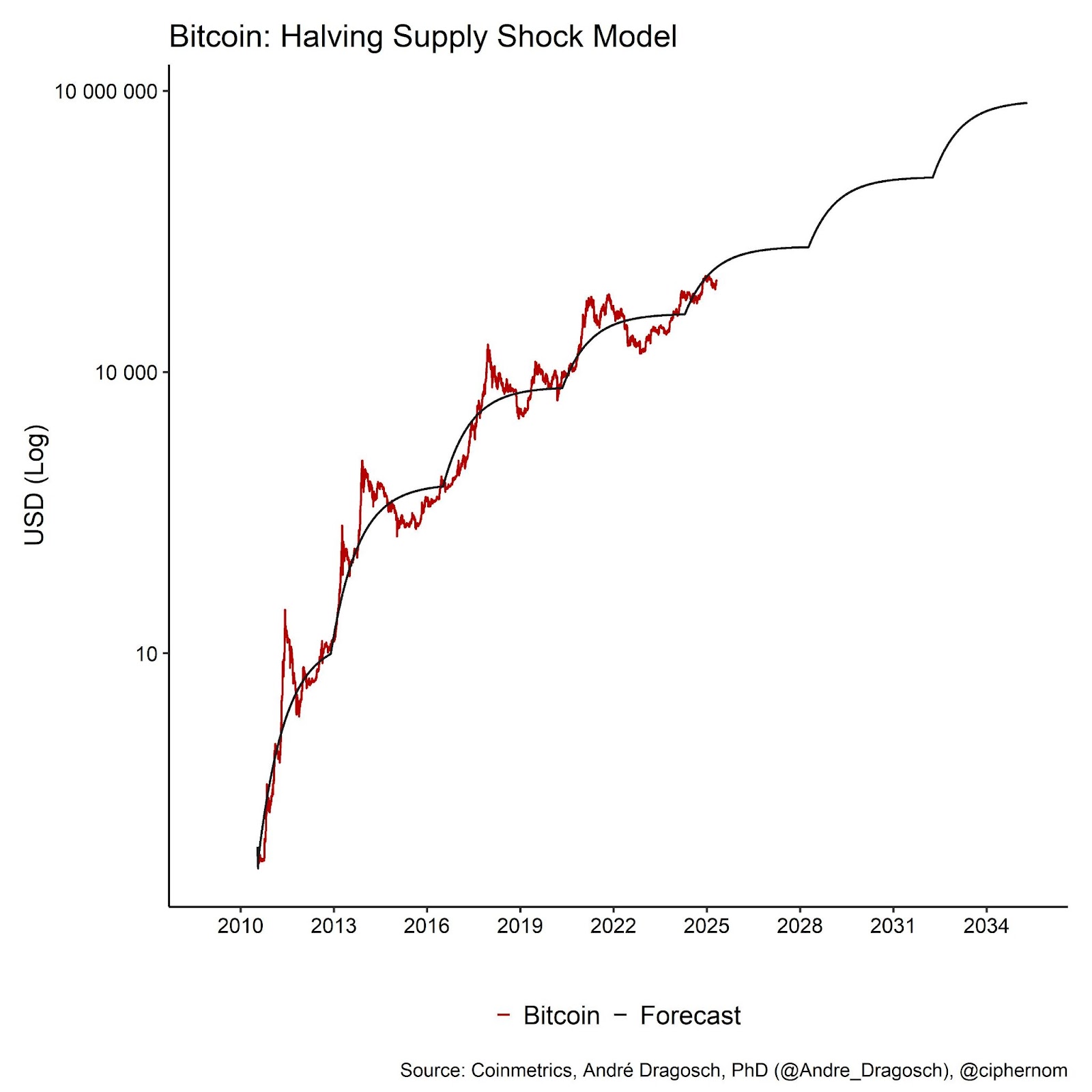
The analysis here further suggests that the impact of the Halving will unfold progressively, as the supply shortfall created by the event gradually intensifies; it can be inferred that the market has not yet fully incorporated the Bitcoin Halving into its pricing.
Based on the above-mentioned model for bitcoin’s increasing scarcity, bitcoin exhibits significantly higher long-term expected returns than traditional assets such as equities, bonds, gold or real estate:
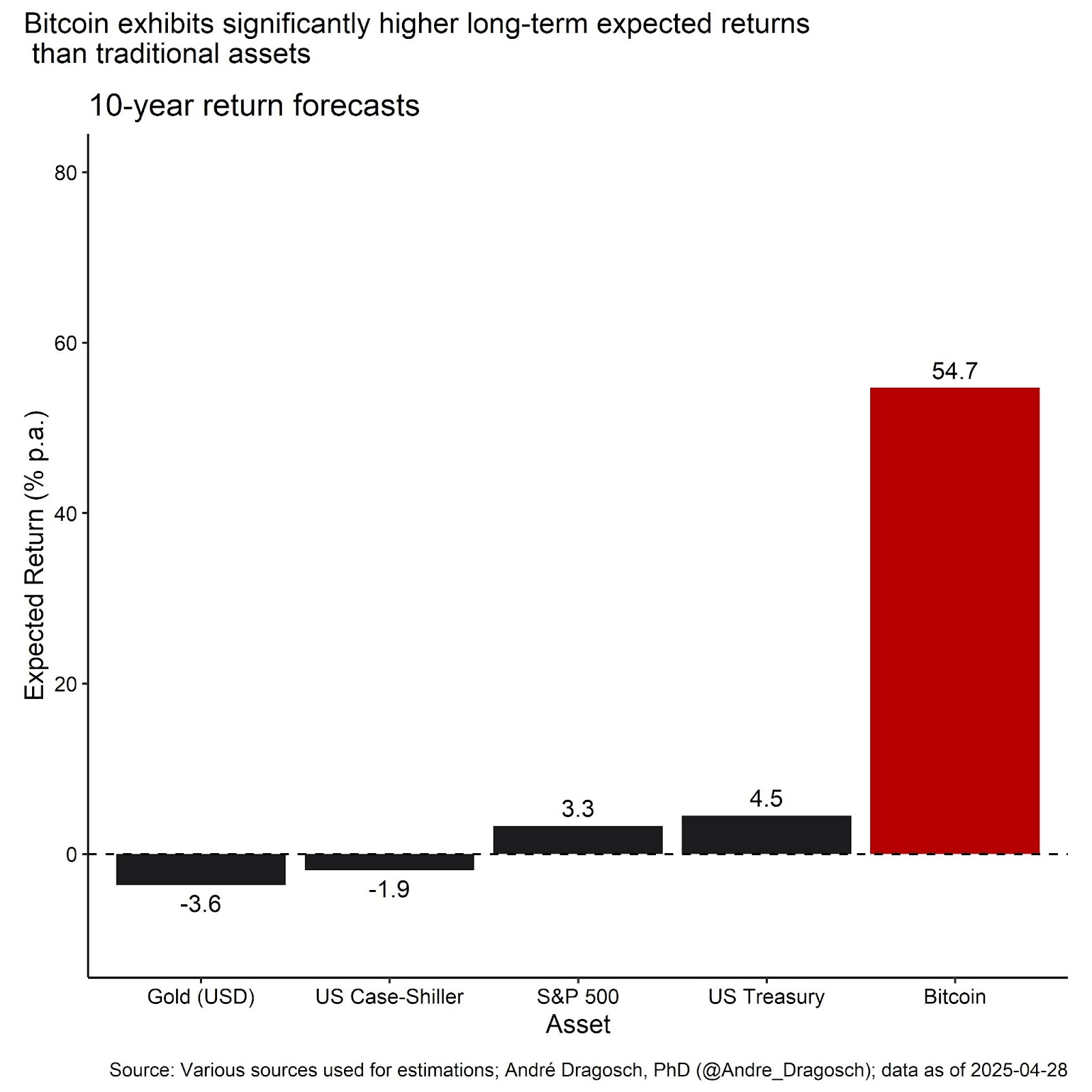
In the very long term, one should expect bitcoin to dematerialize traditional stores of value like gold and U.S. Treasuries on account of this increasing scarcity and supremacy as a monetary asset.
Gold is likely to be technologically disrupted as a store of value because of the combination of Bitcoin’s spatial and temporal transferability not applicable to gold.
U.S. Treasuries, which have essentially leapfrogged gold as a store of value in the post-Bretton Woods fiat monetary system, will be disrupted on account of the likely worsening fiscal situation of the U.S. (historically leading to financial repression and loss in the real value of Treasuries).
The potential investment implication of such a scenario for Bitcoin are vast. Hypothetically speaking, if bitcoin disrupted gold as the primary store of value and achieved a similar market cap as gold today, this would imply a theoretical price of close to $1 million per bitcoin. If bitcoin disrupted U.S. Treasuries as the primary store of value and achieved a similar market cap as today, this would imply a theoretical bitcoin price of approximately $1.4 million.
The different hypothetical prices are shown in the bar chart below.
This is not a far-fetched scenario. As has been demonstrated previously, bitcoin will become almost 10 times as scarce as gold by the year 2032 (based on the stock-to-flow ratio) and will continue to become even scarcer over time in the future. One should expect this increasing scarcity of bitcoin to go hand in hand with an increasing monetary premium of bitcoin at the expense of other traditional stores of value.
In general, bitcoin will likely continue to cannibalize the monetary premium inherent in other traditional stores of value, such as gold or real estate.
Is Bitcoin an Inflation Hedge?
Bitcoin is a scarce digital asset. The algorithm dictates not only a gradual reduction in price-inelastic supply growth but also an ultimate limit of its circulating supply that will converge toward 21 million coins in the long run.
The absolute scarcity of bitcoin, combined with its disinflationary supply growth schedule, makes it a potential candidate as a hedge against inflation.
In fact, bitcoin’s performance has shown a close correlation to global money supply growth, i.e., global monetary inflation over time.
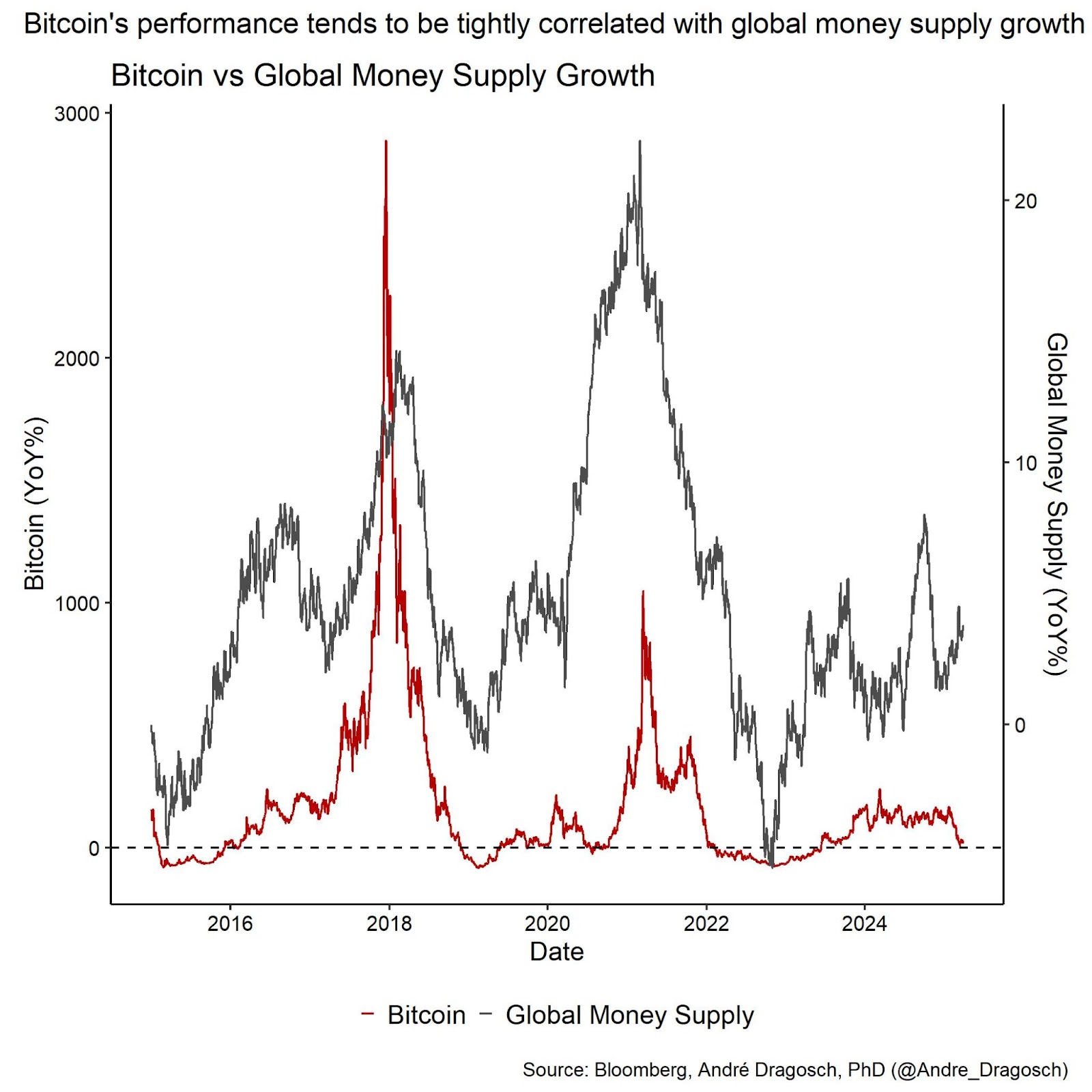

What is more is that bitcoin has shown an increasing sensitivity to market-based inflation expectations such as medium-term U.S. CPI swap rates or U.S. TIPS breakeven rates.
In this context, it is important to note that bitcoin has not always shown this close correlation to inflation expectations: During the earlier epochs of Bitcoin, i.e., from its inception in 2009 until around 2020, bitcoin’s price showed little correlation to market-based inflation expectations.
This has significantly changed since the Covid crisis and the resulting monetary and fiscal stimuli, which also coincided with the previous Halving event in May 2020.
It is quite likely that bitcoin’s sensitivity to market-based inflation expectations will increase even further with an increasing supply scarcity going forward.
In this context, easing U.S. monetary policy amid high U.S. fiscal deficits and increasing inflation expectations could provide an additional tailwind for bitcoin going forward.
The reason is that countries with higher inflation rates tend to see an increased adoption of bitcoin as a store of value as well. In general, countries with high inflation tend to show higher rates of cryptoasset adoption as well. The highest adoption rates tend to be observed in emerging markets which tend to have structurally higher rates of consumer price inflation and money supply growth rates as well.
Is Bitcoin a Hedge Against Sovereign Default?
Unlike a centralized sovereign entity, Bitcoin is a decentralized global network. Transactions can be conducted permissionless and are not subject to censorship by a central authority. This renders assets held on the Bitcoin blockchain essentially unconfiscatable and free of counterparty risk. The fiscal situation of major developed countries like the U.S. or U.K. has come under more scrutiny recently as debt-to-GDP ratios continue to be high while interest expenses are increasing rapidly on account of the recent tightening in monetary policy by the Fed and other major central banks.
As far as the U.S. is concerned, annualized interest expenses have recently surpassed $1 trillion, which is more than the annual military spending or the expenditures related to Medicaid. The Congressional Budget Office forecasts that (gross) interest expenditures will likely reach $3 trillion a year by the end of this decade, while the annual budget deficit will continue to widen. So, the probability of a sovereign default is likely going to increase.
Central banks have recently admitted that even U.S. Treasuries, once regarded as the ultimate safe-haven asset and basis of the global financial system, are not as safe anymore as they used to be. In this context, bitcoin can be viewed as an attractive hedge against a potential sovereign default as a censorship-resistant and permissionless asset, free of counterparty risk.
A modelling approach in this regard was also put forth by Greg Foss. The general idea is that bitcoin could act as a hedge against a basket of major sovereigns’ debt/bonds. Theoretically speaking, if this were the case, bitcoin’s market cap should be equal to the current market value of this basket of sovereign debt multiplied by the weighted probability of default. In case of a cross default of all sovereign debt within the basket (100% default probability), bitcoin’s market cap should reach the same level as the market value of sovereigns it tries to hedge against.
The following chart shows the G20 sovereign’s default probability implied by their 10-year CDS spreads.
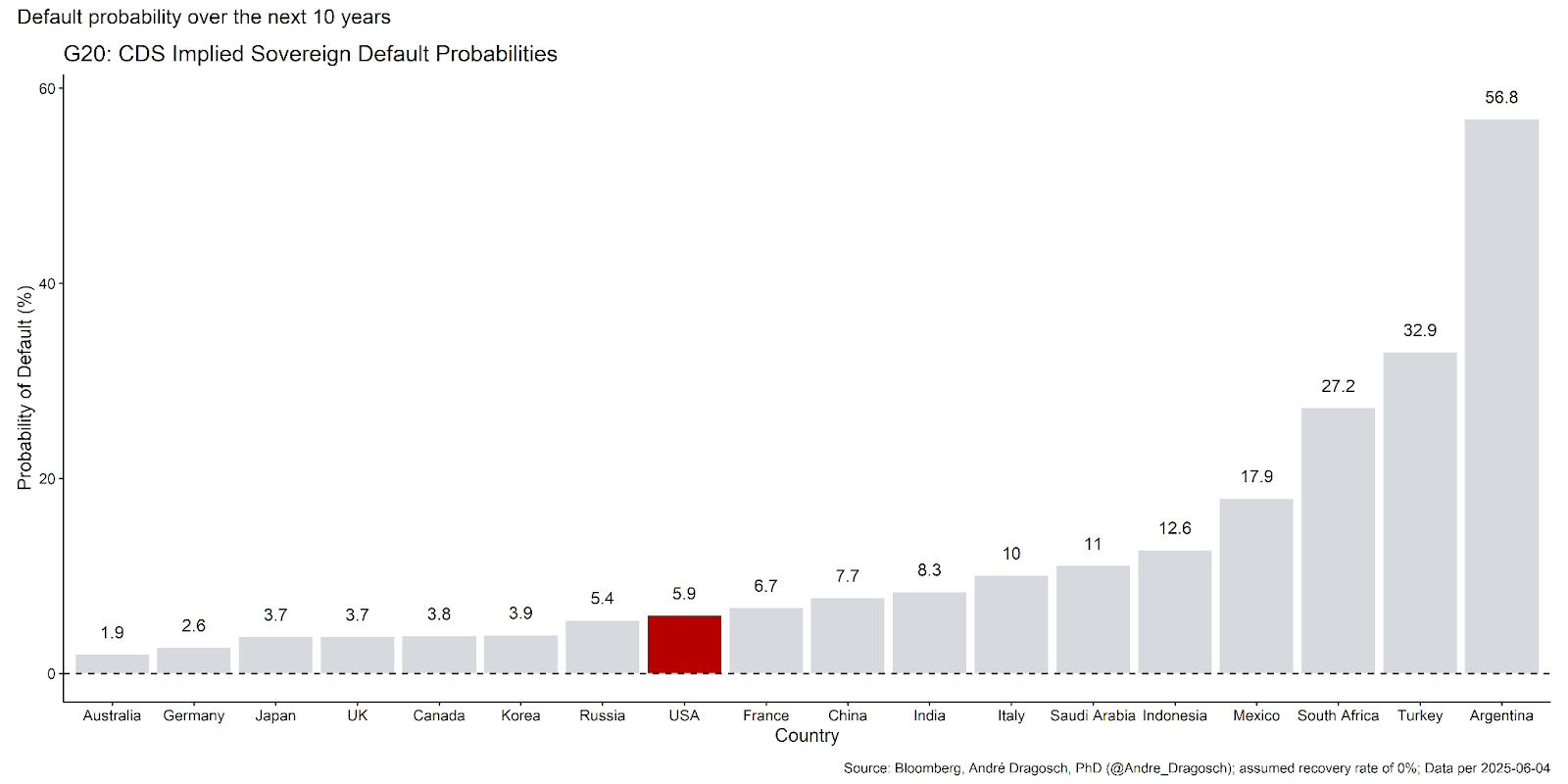
For instance, the market prices a default probability of around 5.0% for the U.S. over the next 10 years. (We assume a 0% recovery rate, which tends to lead to even more conservative estimates in our case.) If we multiply these probabilities by their respective market values of domestic and international sovereign debt, we get the theoretical market value of sovereign debt that is “at risk” and for which bitcoin could serve as a hedge. After dividing this market value by the number of bitcoins in circulation you arrive at the “fair value” for a single bitcoin based on this model. Based on this approach, the current “fair value” of bitcoin would be around 232,000 USD per coin if it were to hedge the implied market value of G20 sovereign debt that is at risk.
As far as the question whether bitcoin is an inflation hedge is concerned, it is worth looking at bitcoin’s performance against inflation relative to other major asset classes.
The idea behind this analysis is to check whether bitcoin could preserve purchasing power and generate a positive real/inflation-adjusted return in any given year.
In fact, the table below not only reveals that bitcoin exhibited the highest average real return since 2010 but also that bitcoin managed to outperform U.S. CPI inflation in more than 80% of the years considered.
Both U.S. real estate and U.S. large-cap equities (S&P 500) could similarly beat U.S. inflation, although with significantly lower nominal and real returns.
In contrast, both U.S. government bonds and overall commodities (BBG Commodity Index) have historically been bad at preserving purchasing power. Gold appears to be an exception among commodities but its return is also not phenomenal.
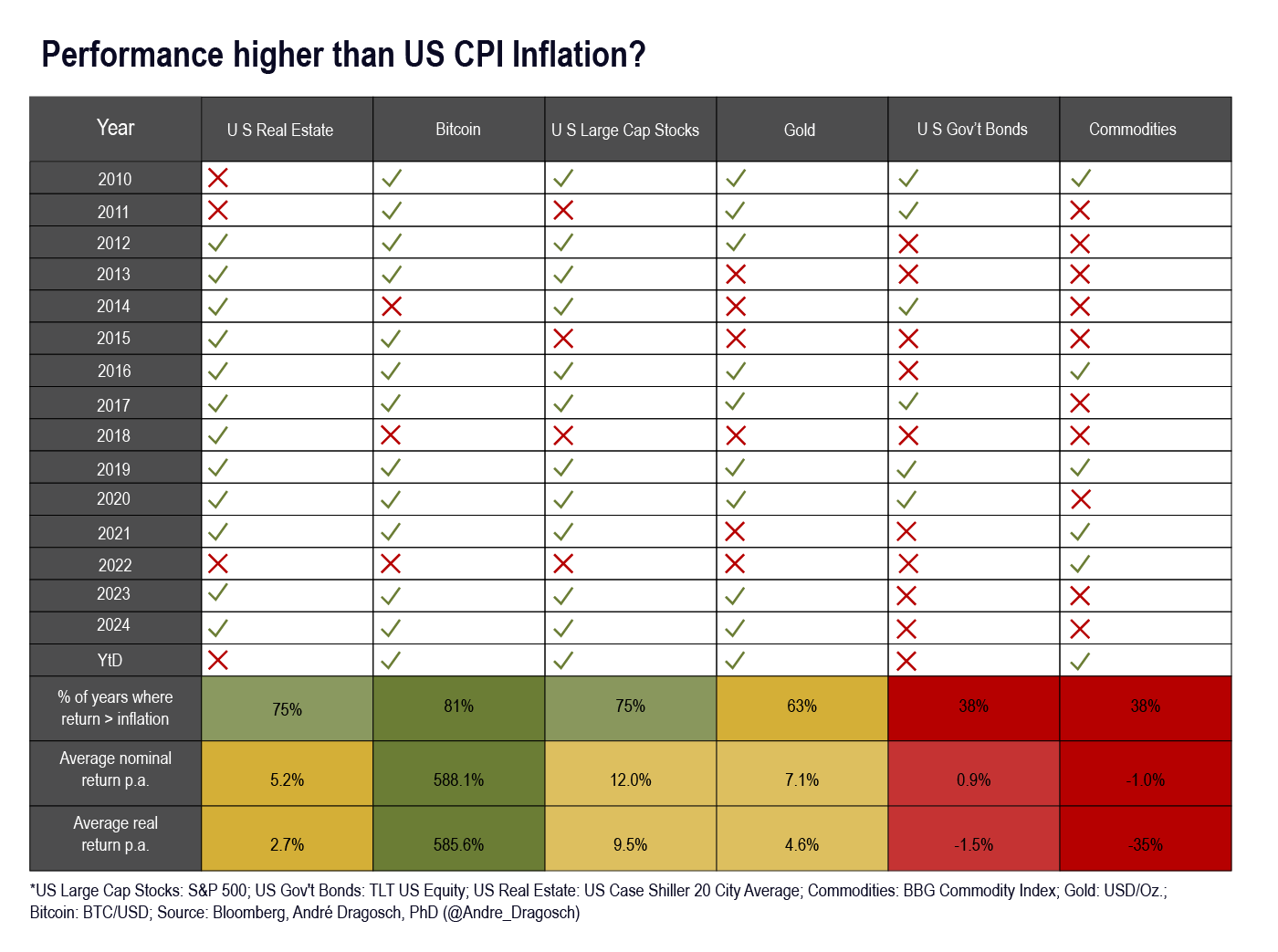
Is the 4-year Bitcoin cycle “dead”?
Some market observers have started to challenge the historical pattern of bitcoin to rally in the years around the Halving — which happened in 2012, 2016, 2020, and 2024 so far.
The reason is that the supply deficit induced by the Halving has become smaller over time in relation to the existing supply of bitcoin in circulation.
For instance, while the first Halving in 2012 induced a supply deficit of 25 BTC per block every ~10 minutes (approximately 12.5% of the supply per year), the latest Halving in 2024 has only induced a supply deficit of 3.125 BTC per block (approximately 0.83% of supply per year).
This decline in the Halving effect is often seen as a reason why bitcoin has been exhibiting diminishing returns with each new subsequent Halving cycle:

However, the view that bitcoin will continue to exhibit diminishing returns in the future is increasingly being challenged.
The key reason is that adoption appears to be accelerating globally and demand factors are becoming increasingly more important than supply factors.
In fact, 2024 was the first year in bitcoin’s history where demand from global bitcoin ETPs and other institutional sources have outweighed the Halving effect and this trend is likely going to continue, especially if you assume that institutional adoption by ETPs, corporations and governments starts to grow exponentially — the assumption underlying the model of technological adoption by Rogers.

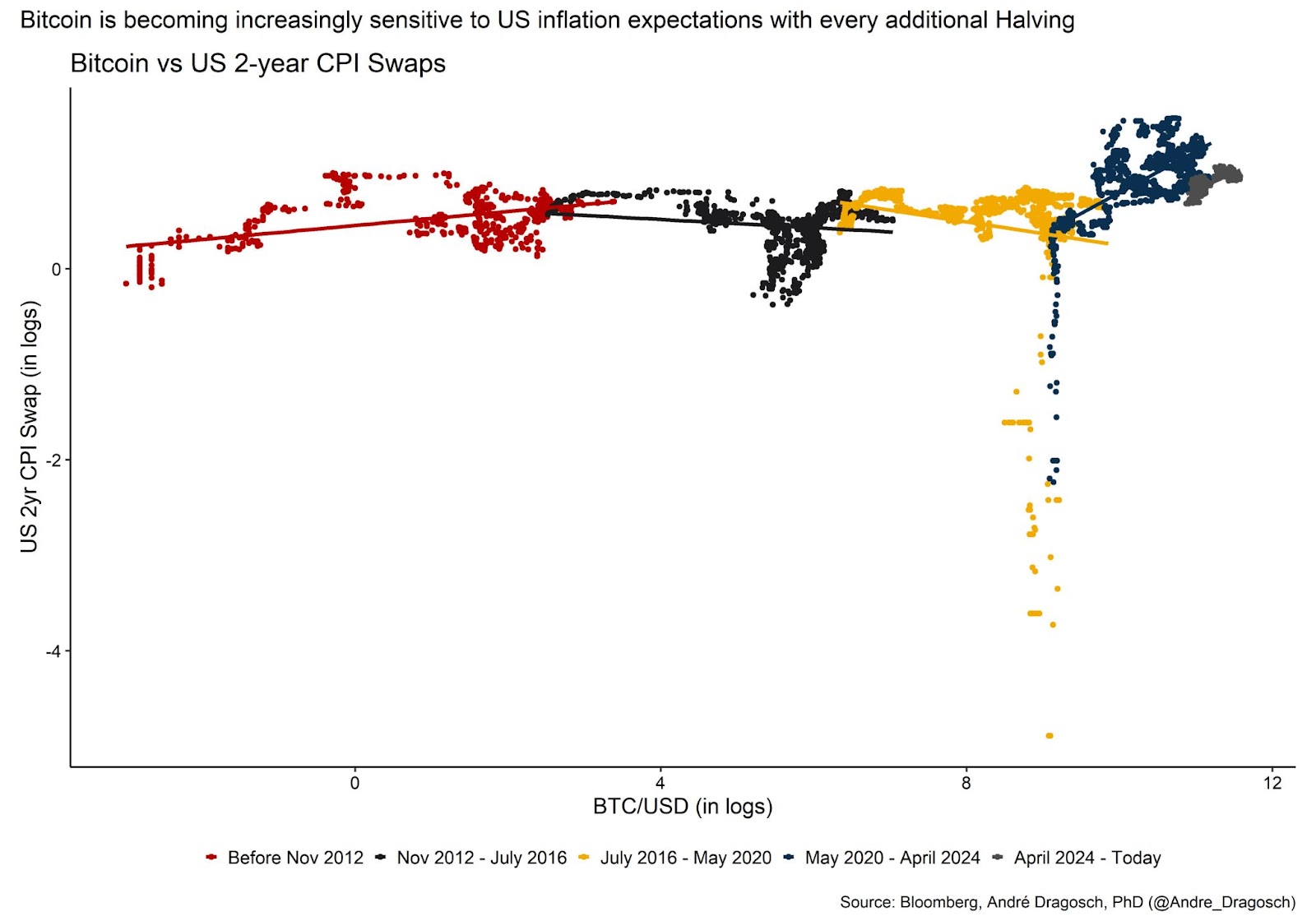
Such a scenario would seriously challenge the assumption that bitcoin will continue to adhere to the 4-year cycle and also exhibit diminishing returns in the future.
Some models, like the one presented by Rudd and Porter, have tried to estimate this exponential growth trajectory as well. Their model estimations conclude that bitcoin could already reach $1M per coin by January 2027 due to the significant increase in demand via factors like institutional and nation-state adoption.
This expectation also underpins the core hypothesis of this book: that bitcoin sits at the intersection of absolute scarcity of supply and exponential demand growth.
…hence, the title of the book: Exponential Gold.
This view actually implies that average returns in each cycle should increase over the coming years, especially on account of the growing supply scarcity on bitcoin exchanges. According to the latest estimates by Glassnode, only around 3 million bitcoin remain on exchanges (15.2% of the circulating supply).
It also implies that macro factors that influence demand such as global growth expectations, cross-asset risk appetite and monetary policy will become more important for bitcoin’s market cycles over time.
As trust in the established systems erode, trustless hard assets have become favorable again. It is no surprise that both gold and bitcoin have been the best-performing assets in 2024, and bound to repeat this feat in 2025.
Major companies are also establishing bitcoin as a corporate treasury asset in order to mitigate the constant erosion of purchasing power of their cash holdings, and maximize value for their shareholders.
It is quite likely that we are already at an inflection point with respect to global bitcoin adoption, as adoption growth starts to accelerate once it crosses the chasm from the “early adopters” to the “early majority.”

André Dragosh is the head of research for Bitwise in Europe. He holds a Ph.D in financial history from the University of Southampton. This is an extract from his book Exponential Gold: An Institutional Investor’s Guide to Bitcoin & Cryptoassets, self-published with support from the European book publisher Konsensus Network on June 3, 2025. It is re-published here with the author’s permission. (Full disclosure: Joakim Book edited the book and was remunerated for his services by Konsensus.)
This post Bitcoin and the Next Wave of Institutional Capital first appeared on Bitcoin Magazine and is written by André Dragosh.

 (@Andre_Dragosch)
(@Andre_Dragosch)